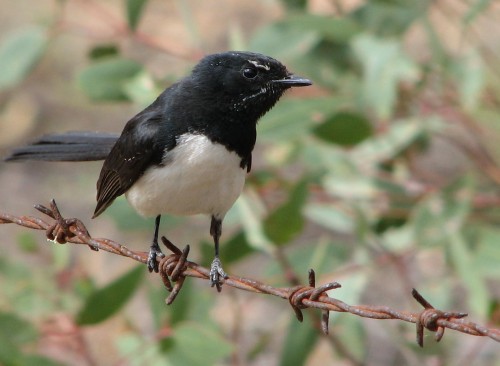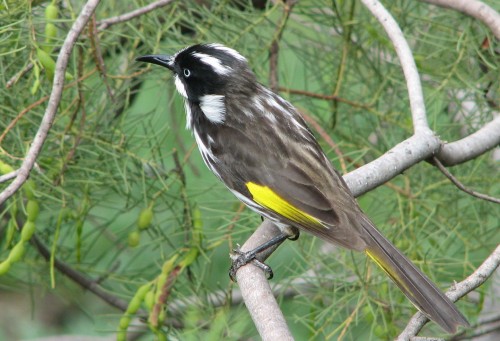Great Birding Moments #6 New Holland Honeyeaters
We have many flowering trees and bushes in our garden on the outskirts of Murray Bridge in South Australia. As a result of all these plants there is a steady supply of food for many species of birds, especially a range of honeyeaters. Over the last 22 years we have recorded the following species of honeyeaters:
- Red Wattlebirds – resident, breeding, very common.
- White Plumed Honeyeaters – resident, breeding, very common.
- Spiny Cheeked Honeyeater – resident, breeding with only several present at any one time.
- Brown Headed Honeyeater – regular visitor, breeding and usually in groups of 8-12.
- Noisy Miner – only one doubtful record many years ago despite being common along the River Murray less than 5km away.
- Striped Honeyeater – occasional visitor, recorded breeding only once which remains probably the most south-westerly record of breeding in Australia.
- White Eared Honeyeater – occasional visitor despite being widespread in this area.
- Yellow Plumed Honeyeater – occasional visitor.
- New Holland Honeyeater – resident, breeding and very common.
- Singing Honeyeater – resident, breeding and common.
New Holland Honeyeaters
The most prominent species has to be the the New Holland Honeyeater. This was not always the case. When we moved here we never saw any New Hollands despite being very common throughout Murray Bridge and the district. After the first few migrated to our garden, the numbers increased rapidly until they are now the dominant species. They are also rather aggressive. (See my posting called “Aggressive bird behaviour in the garden.”)
Distribution and Habitat
New Holland Honeyeaters are widely distributed along coastal south-eastern Australia. They are also found in southern Western Australia and in Tasmania. They prefer gardens, parks, golf courses, orchards, mallee, heathlands, coastal scrubs and eucalypt woodlands. They are often found in association with other honeyeater species towards which it acts aggressively, chasing them away from their preferred flowering plants.
Photo opportunities
I have had many opportunities to photograph this species over the last year. The best is the one featured at the top of this post. I was near the neighbour’s fence looking at the old plough set as a garden ornament. The bird alighted on the handle only three metres away and settled long enough for me to zoom in, focus and shoot. I am very pleased with the result; it couldn’t have posed better if I’d given it instructions.
The photo below is of another bird, and yes, it is up the right way. It’s the bird that’s upside down!
Great Birding Moments #4 Willie Wagtail
The Willie Wagtail is a resident of our garden here in Murray Bridge. Our house is situated amongst 5 acres (2 hectares) of a mixture of garden plants, orchard, mallee scrub (mallee is a species of eucalypt) and open paddock.
Camera shy
Our resident Willie Wagtails seem to be rather camera shy. I’ve been trying for many months to get a good photo of this species here at home. Whenever I’d try to get close enough they’d be high in the foliage of the tree – or behind a bush – or they’d flit away before I could focus. Eventually I did manage to get a nice shot; the bird is good but the setting is horrible. I wish there was some way of masking out the rubbishy looking drum it has perched on. And look at all those weeds in the background!
Breeding
The Willie Wagtail Rhipidura leucophrys, a member of the flycatcher family of birds, is one of Australia’s best known and well-loved birds. They are common throughout Australia and northern Tasmania. They are easily recognised as they flit around looking for a feed, tail wagging and fanning out disturbing insects. “Our” Willie Wagtails are a resident breeding pair. They usually have at least one and sometimes two broods each year, usually in spring and summer.
The Nest
The nest is a cup-shaped bowl about 5-6cm wide and deep. It is usually made from cobwebs, fine grass, feathers, wool, bark and other soft materials. It can be situated as low as a metre from the ground to 10 or even 15 metres high up in a tree. It is often located on horizontal branch but I have seen nests made on a metal strut inside a farm shed. They most often lay 2 or 3 eggs, but occasionally lay 4. To see four almost fledged baby Willie Wagtails in a small nest all reaching out to mum or dad begging for food, one wonders how the nest survives – and how they don’t topple out! The nest seems just right for one baby – three or four is definitely overcrowded. The interesting thing about “our” WWs is that they always nest very close to the house, usually within 15 metres.
Related articles:
Aggressive Bird Behaviour in the Garden
While working in the garden yesterday morning I was suddenly alerted to a noisy confrontation nearby. Our resident Willie Wagtails love to frequent one particular spot where there is an abundance of insects.
Suddenly a New Holland Honeyeater dived in to reap his share of the smorgasbord. The Willie Wagtail became quite aggressive, fanning his tail up high, ruffling the feathers all over and calling in what seemed to me to be in quite an angry – perhaps even distressed – way.
The honeyeater retreated to a nearby tree, only to swoop in repeatedly over the next few minutes. Each time the honeyeater would snap at the Willie Wagtail, zip away a metre or so, grab another insect, and retreat hurriedly to the refuge tree.
These attacks seemed to trigger even more aggression in the Willie Wagtail who decided to front up to the interloper. They then faced each other at about ten paces (bird step size – about 10cm) angrily calling in each others’ face. One last beakful of food and the New Holland Honeyeater decided that other parts of the garden were more attractive anyway, and it flew off. The Willie Wagtail continued to feast contentedly on his little patch.
Further reading:
- Aggressive birds – articles from my archives
This post updated in September 2015.




